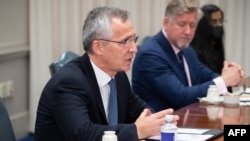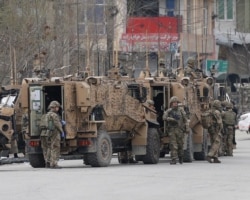There is no guarantee that Afghanistan’s government and security forces will succeed, or even survive, once the last U.S. and coalition troops leave the country, according to a blunt assessment from NATO’s top official.
“We have to face the reality there is, of course, a lot of uncertainty,” Secretary General Jens Stoltenberg told a virtual audience Monday before meetings at the Pentagon and the White House.
“The decision to leave entails risks,” he said.
According to U.S. Central Command (CENTCOM), which oversees American troops in the Middle East and South Asia, the U.S. withdrawal is nearing the halfway point, with the last U.S. forces, civilian contractors and equipment set to be out of Afghanistan by early September at the latest.
NATO’s own drawdown, involving approximately another 7,000 troops, is also “on track,” Stoltenberg said, defending the decision to send troops home after nearly two decades of battling the Taliban and terrorist groups like al-Qaida and Islamic State.
“You have to remember that in one way, this is a gradual development," Stoltenberg said. “Not too many years ago, we had more than 100,000 troops in a big combat operation."
“Over these years, we have been able to build, train Afghan security forces so they are now responsible for security in their own country," he added.
Yet doubts about the ability of the Afghan security forces to function without substantial, on-the-ground support from U.S. and NATO forces persist.
Since U.S. troops began pulling out last month, Taliban forces have seized at least seven districts, taking some without meeting any resistance.
And a report issued last week by the United Nations Sanctions Monitoring Team for Afghanistan warned that Taliban commanders have increasingly positioned their forces to take by force what they cannot get through negotiations “when levels of departing foreign troops are no longer able to effectively respond."
Top. U.S. military commanders have also voiced concern about “the ability of the Afghan military to hold on” once U.S forces and contractors leave.
Still, NATO’s secretary general emphasized Monday that even though NATO forces are departing Afghanistan, the alliance will continue to provide financial support and will also maintain a civilian presence in Kabul to advise Afghan security forces and help them build their capacity.
"We are not ending our support for the Afghans," Stoltenberg said, adding that NATO is also continuing to explore ways to provide additional training for the Afghan special operation forces.
"We can train Afghan forces in other countries, and we are looking into how we can provide that kind of support," he said.
But those plans are short on specifics, with much still to be worked out.
“We are now looking into the details and consulting closely on our next steps,” a NATO official told VOA when pressed for details.
Other plans, to maintain the U.S. and coalition’s ability to launch counterterrorism strikes, if needed, also remain unclear.
"We have had constructive discussions in the military, intelligence and diplomatic channels about the future of America's capabilities," White House National Security Advisor Jake Sullivan told reporters Monday, when asked about the possibility of opening bases for U.S. drones in Pakistan.
"In terms of the specifics of what that will look like, that will have to remain in those private channels as we work through them," Sullivan said, adding the U.S. is talking to “a wide range of countries about how we build effective over-the-horizon capacity, both from an intelligence and from a defense perspective."
In a separate phone briefing with reporters earlier Monday, the commander of U.S. forces in the Middle East and South Asia also defended the planning process.
"Our plans are very far advanced on what our posture is going to look like after we complete the withdrawal," CENTCOM’s General Kenneth “Frank” McKenzie said, declining to elaborate.
“It's not an appropriate time to share that information," he said. "Those are tactical questions which could give advantage to those who would attack us."
The U.S. has pledged to continue to provide Afghanistan’s security forces with financial support.
U.S. President Joe Biden’s proposed fiscal 2022 budget calls for $3.3 billion in military aid for Afghan forces — a slight increase over current funding levels.
On Sunday, an Afghan government spokesman said the U.S. has promised to sustain that level of funding through at least fiscal year 2023.
White House Bureau Chief Steve Herman contributed to this report.







